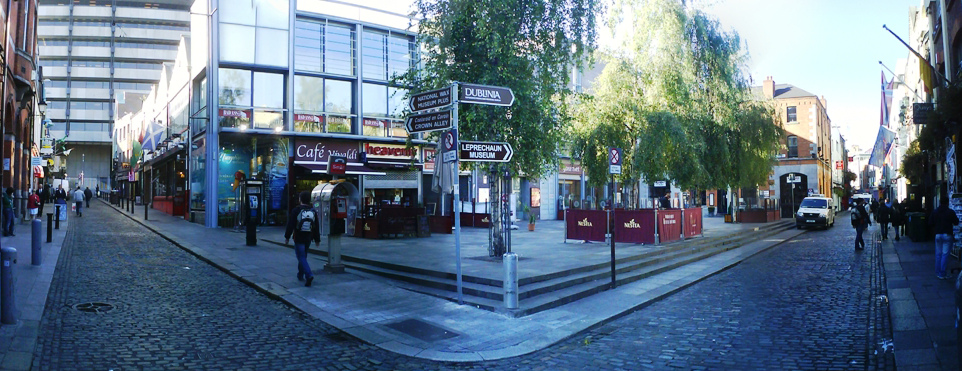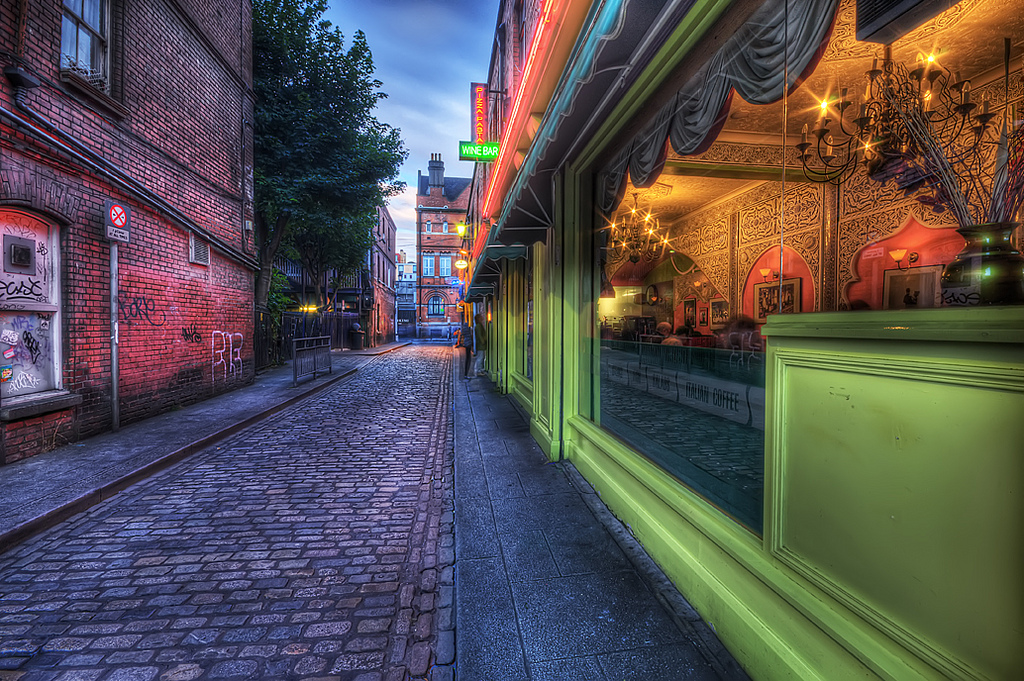Temple Bar is often been described as a pub by plenty of British people that have gone all the way to Dublin for a holiday, and then come back without realising that it is actually one of Dublin’s most historically rich, culturally vibrant and interesting districts. It is full of holiday attractions, including museums, theatres and places for the kinds (for example the Ark). It is also absolutely rammed with places to stay during your holiday or short break. Hotels, and hostels abound, whilst you are never more than a few metres away from an excellent pub and restaurant. To go to Dublin for a holiday and not visit Temple Bar would be a real mistake.

What is Temple Bar?
Temple Bar is at least three different things, all in one rather small place: Firstly it’s an area of deep historical significance and value – full of old buildings, cobbled streets and stories. Secondly, Temple Bar is a current cultural hotspot which rivals Northside’s Parnell Square as Dublin’s cultural capital. Thirdly, Temple Bar is an area of magnetic attraction to ferry-loads and plane-loads of British tourists coming to Dublin in celebration of Hen Nights and Stag Dos. The contrast between the first two (culture and history) with the third, (drunken revelling, fancy dress and mayhem) can be very stark.
Temple Bar is a fairly compact series of narrow, old, cobbled streets. The Area is hemmed in by the very long Dame Street- to its South- and the even longer River Liffey -to its North. To the East and West, Temple Bar is bounded by Fishamble Street and Westmorland Street, respectively.
These old narrow streets, and the historical building that lie on them, boast a huge and varied array of businesses: from the arty to the awful; from nightclubs to ancient cobbled streets. A trip to Temple Bar during your Dublin holiday is an absolute must. Temple Bar is so diverse and rich in terms of architecture, shops, restaurants and accommodation options, that no matter what your holiday budget and expectations there will inevitably be something that surprises and appeals to you.

How to get to Temple Bar
Temple Bar is really close to O’Connell Street; Busaras (where people conclude their ferry trip from the UK to Dublin-unless they take a car on the ferry); and Connolly- the major train station in Dublin. Those who are staying North of the river during their holiday, enjoy crossing the Ha’penny Bridge from North to South, which will lead straight into Temple Bar. Crossing this Bridge often represents the end of an afternoon of sightseeing and begins an evening on the town in one , or many, of Temple Bar’s many pubs and night clubs.
Temple Bar is in Dublin 2. O’Connell Street and some of the other main streets in Central Northside are part of Dublin 1. Whether you have just arrived in Dublin by ferry (and been dropped off at Busaras), have arrived by train, or are staying on the Northside, the best way to get to Temple Bar is via O’Connell street and onto the Quays. The first route you can take, from the Liffey side of O’Connell street, is to cross O’Connell Bridge. Once you are on the South side of O Connell Bridge you will turn right and follow Aston Quay and Crampton Quay, until you get to the Ha’penny Bridge. You wont cross the Ha-Penny Bridge, but will, instead turn left into Merchant’s Arch. Once through Merchant’s Arch you will be opposite Quay’s Bar – a good opportunity for your first pint of ‘the black stuff’ in Temple Bar.
You can also get to Temple Bar, from the Liffey side of O’Connell Street by turning right just before O’Connell Bridge. By turning right before O’Connell Bridge you will follow Bachelor’s Walk, until you get to the Ha’penny Bridge. Crossing this bridge will take you to the south side of the Liffey and you will be just opposite the Merchant’s Arch.

Does Temple Bar have any History that is worth looking into?
Many British holidaymakers arrive in temple Bar without any real knowledge of the area’s rich history and cultural significance. By walking to Temple Bar through O’Connell Street, along the Quays, over the Ha-penny Bridge, and under the dark and foreboding Merchant’s Arch, you will be well-warmed up for the surprises and delights that await the discerning eye inside Temple Bar. Merchant’s Arch and it’s premises originally served as a meeting and Guild house for Tailor’s. These days a fashionable bar/restaurant does business in this beautiful old building that dates all the way back to 1821. This is Temple Bar all over: beautiful old – in this case Dickensian – building housing the bright lights of a very modern and successful 21st century restaurant and bar.
Temple Bar’s history stretches all the way back to pre-Norman times (1204). However, when the Norman invaders began to build Dublin Castle, which is just to the South of Temple Bar, the area began its slow evolution. From their base in Dublin Castle, the Norman invaders needed to access the Liffey through Temple Bar; roads, transport and buildings began to spring up within what is now Temple Bar.
Temple Bar really began to emerge as a unique part of Dublin in the 1800s. With its huge array of artisans and small shops Temple Bar began to gain the reputation for crafts and culture that it enjoys today. Many of the buildings and streets that sprang up in temple Bar in the late 1700 and early 1800s remain virtually intact today. So when you are in Temple Bar on your holiday, or stag do try not to drink too much or misbehave: you will be misbehaving on the cobbled streets of history!
Temple Bar suffered a reversal in its fortunes in the early and mid 1900s and at one stage the City Council planned to turn the area into a Bus Station. However whilst the Council made plans to build the new station they leased many of the buildings to small artisans, art galleries, and other culturally minded organisations.
Very quickly Temple Bar developed a reputation in Ireland, the UK, and farther afield as a great cultural centre. Slowly Temple Bar began to develop the reputation as a hive of Culture, activity, and an absolute must see area for anyone on holiday in Dublin.
Temple Bar began to develop its reputation showy Nightclubs, Bars and Restaurants in the 90s. These pubs and clubs gained a reputation for being the perfect venue to celebrate a stag or a hen do. Whilst Temple Bar still hosts many British stag and hen dos, many more adventurous types now make the trip to Eastern Europe or even further afield. The great thing about the trip to Dublin, though, is that it is fairly exotic, but still close enough – in terms of culture- to England that you will feel comfortable. An added bonus is that you will be able to understand the lingo- unless you get chatting to someone from Cork!
What does Temple Bar mean? How did it get its name?
This is open to debate. Some say the ‘Temple’ part of the name is attributable to the Englishman, Sir William Temple who built a beautiful house and gardens in the area in the 1600s.
The ‘Bar’ in Temple Bar is said to stand for a barrier or a gate closing the entrance to a property. So we could assume that the name, in its most commonly accepted interpretation, means Temple’s enclosed community. Many also attribute this mysterious name to the Templar order of knights: the Knights Templar. They also suggest Temple Bar’s unique development within Dublin is down to historical and enduring Masonic links.
Whilst the most likely reason for the name is in honour of the Temple family, it will be interesting for the international tourist to delve deeper into the fascinating history and mystery of Temple Bar.